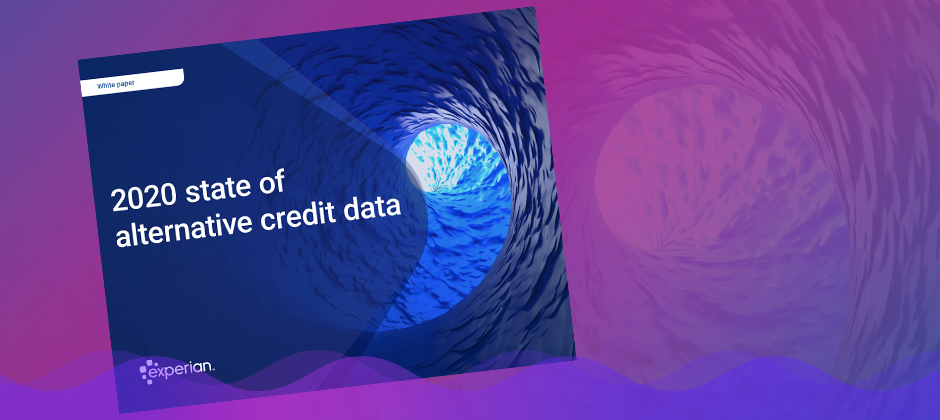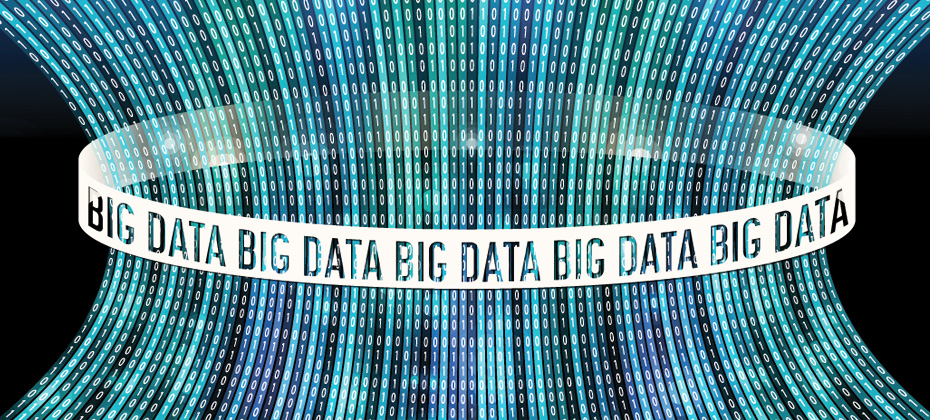Tag: Big Data

Credit scores hold the key to many aspects of our financial lives. Whether qualifying for a mortgage, insurance, or a smartphone plan, financial institutions rely on credit reports — a document detailing how responsibly a person has used credit accounts in the past — to decide if they should approve your financing application. However, here's the problem: because today's scoring system leans heavily on a person’s credit history to generate a credit score, it leaves out large segments of the United States population from accessing credit. According to a recent Oliver Wyman report, an estimated 28 million U.S. consumers are considered ”credit invisible," while another 21 million are deemed "unscorable," meaning they don’t have the types of accounts that have been traditionally used to generate a credit score. Using the traditional credit-scoring formula, certain populations, such as communities of color and low-income consumers, are left behind. Now, times are changing. A modern approach to credit scoring can significantly improve the financial inclusion of millions of U.S. consumers and correct past and present inequities. Tapping into advanced technologies that leverage expanded data assets can produce powerful results. A cycle of exclusion: The limitations of conventional credit scoring A big part of the problem lies with how credit scores are calculated. Between payment history and length of accounts held, a consumer’s credit history accounts for 50 percent of a FICO credit score — the credit score used by 90 percent of top lenders for credit decisions. In other words, the credit system rewards people who already have (or can get) credit and penalizes those that cannot or don't yet have credit. For those who do not have credit, their financial behaviors — such as timely rental and utility payments, bank account data and payday loan installment payments — may not get reported to credit bureaus. As a result, consumers without a credit history may appear as credit invisible or unscorable because they don't have enough tradelines to generate a score. But they also can’t get credit to improve their score. It creates a cycle of exclusion that’s hard to break. Who gets left behind? According to the latest research, the limitations on the traditional credit scoring system disproportionately impact certain communities: Low-income: 30 percent of those in low-income neighborhoods are credit invisible, and 16 percent are considered unscorable, compared with just 4 percent and 5 percent, respectively, in upper-income neighborhoods.1 Communities of color: 27 percent of Black and 26 percent of Hispanic consumers are either credit invisible or unscorable, while only 16 percent of white consumers are.1 Immigrants: People who have recently arrived in the United States can lack a credit history here, even if they may have had one in their home country. Meanwhile, undocumented immigrants, who don’t have a Social Security number, can find it difficult to get a credit card or use other financial services. Young adults: 40 percent of credit invisibles in the U.S. are under the age of 25,1 with 65 percent of 18- to 19-year-olds lacking a credit score. Being labeled unscorable or credit invisible can hinder participation in the financial system and prevent populations from accessing the socioeconomic opportunities that go with it. Why are certain individuals and communities excluded? There are often complex — and valid — reasons for why many consumers are deemed unscorable or credit invisible. For example, newcomers may appear to be credit invisible because haven’t yet generated a credit history in the U.S., although they may have a solid score in their home country. Young consumers are also a common category of unscorable or credit invisible people, largely because they haven't acquired credit yet. Only 35 percent of 18- to 19-year-olds have a credit score, while 91 percent of 25- to 29-year-olds do. However, those who can quickly get a credit history typically come from wealthier households, where they can rely on a creditworthy guarantor to help them establish credit. Finally, some consumers have had negative experiences with the financial system. For instance, a prior default can make it difficult to access credit in the future, which can result in an extended period without credit, eventually leading to being labelled unscorable. Others may distrust the mainstream financial system and choose not to participate. Underpinning all this are racial disparities, with Black and Hispanic consumers being classified as unscorable and credit invisible at significantly higher rates than white and Asian consumers. According to the Consumer Financial Protection Bureau (CFPB), Black and Hispanic people, as well as low-income consumers, are more likely to have “scant or non-existent” credit histories. Financial inclusion is an equity issue Traditional credit scoring places big barriers on certain communities. Without access to credit, marginalized communities will continue to face challenges. They will lack the ability to purchase property, secure business and/or personal loans and deal with financial emergencies, further widening the wealth gap. Since credit scores are used to decide loan eligibility and what interest rate to offer, those with low or no credit rating tend to pay higher interest rates or are denied desired loans, which compounds financial difficulty. The impact is profound: a significant percentage of the population struggles to access basic financial services as well as life opportunities, such as financing an education or buying a home. Without the ability to generate a credit score, unscorable or credit invisible consumers often turn to less-regulated financial products (such as payday loans or buy now pay later agreements) and pay more for these, often locking them in a vicious cycle. Consumers who are credit invisible or unscorable often end up paying more for everyday transactions. They may be required to put up hefty deposits for housings and utilities. Auto and homeowners insurance, which use credit score as a factor in setting rates, may be more expensive too. Consider how much this could impede someone’s ability to save and build generational wealth. Financial inclusion seeks to bring more consumers into the financial system and enable access to safe, affordable financial services and products. With the right technology on your side, there are solutions that make it easier to do so. Tap into technology Banks, credit unions and other lending institutions are well positioned to move the needle on financial inclusion by embracing expanded definitions of creditworthiness. By seeking out expanded FCRA-regulated data with wider sources of financial information, financial institutions can find a vast untapped pool of creditworthy consumers to bring into the fold. Technology makes achieving this goal easier than ever. New credit scoring tools, like Lift Premium™, can give lenders a more complete view of the consumer to use for credit decisioning. It combines traditional credit data with expanded FCRA-regulated data sources, helping lenders uncover more creditworthy consumers. Lift Premium can score 96 percent of U.S. consumers, compared to just 81 percent that conventional scoring systems do now. By applying machine learning to expanded data sets, Lift Premium can build a fuller and more accurate view of consumer behaviors. Moreover, the 6 million consumers whose scores are now considered subprime could be upgraded to prime or near-prime by analyzing the expanded data that Lift Premium uses. The opportunity presented by financial inclusion is significant. Imagine being able to expand your portfolio of creditworthy borrowers by almost 20 percent. The last word With a renewed focus on social justice, it’s no surprise that regulators and activists alike are turning their attention to financial inclusion. A credit-scoring system that allows lenders to better evaluate more consumers can give more people access to transparent, cheaper and safer financial products and the socioeconomic benefits that go along with them. New models and data assets offer additional data points into the credit scoring system and make it possible for lenders to expand credit to a greater number of consumers, in the process creating a fairer system than exists today. Early adopter lenders who embrace financial inclusion now can gain a first-mover advantage and build a loyal customer base in a competitive market. Learn more Download white paper 1Oliver Wyman white paper, “Financial Inclusion and Access to Credit,” January 12, 2022.

Big data is bringing changes to the way credit scores are reported and making it easier for lenders to find creditworthy consumers, and for consumers to qualify for the financing they need. Since last year’s annual report, alternative credit data1 has continued to gain in popularity. In Experian’s latest 2020 State of Alternative Credit Data report, we take a closer look at why alternative credit data is supplemental and essential to consumer lending and how it’s being adopted by both consumers and financial institutions. While the topic of alternative credit data has become more well known, its capabilities and benefits are still not widely discussed. For instance, did you know that … 89% of lenders agree that alternative credit data allows them to extend credit to more consumers. 96% of lenders agree that in times of economic stress, alternative credit data allows them to more closely evaluate consumer’s creditworthiness and reduce their credit risk exposure. 3 out of 4 consumers believe they are a better borrower than their credit score represents. Not only do consumers believe they’re more financially astute than their credit score depicts – but they’re happy to prove it, with 80% saying they would share various types of financial information with lenders if it meant increased chances for approval or improved interest rates. This year’s report provides a deeper look into lenders’ and consumers’ perceptions of alternative credit data, as well as an overview of the regulatory landscape and how alternative credit data is being used across the lending marketplace. Lenders who incorporate alternative credit data and machine learning techniques into their current processes can harness the data to unlock their portfolio’s growth potential, make smarter lending decisions and mitigate risk. Learn more in the 2020 State of Alternative Credit Data white paper. Download now

In today’s ever-changing and hypercompetitive environment, the customer experience has taken center-stage – highlighting new expectations in the ways businesses interact with their customers. But studies show financial institutions are falling short. In fact, a recent study revealed that 94% of banking firms can’t deliver on the “personalization promise.” It’s not difficult to see why. Consumer preferences have changed, with many now preferring digital interactions. This has made it difficult for financial institutions to engage with consumers on a personal level. Nevertheless, customers expect seamless, consistent, and personalized experiences – that’s where the power of advanced analytics comes into play. It’s no secret that using advanced analytics can enable businesses to turn rich data into insights that lead to confident business decisions and strategy development. But these business tools can actually help financial institutions deliver on that promise of personalization. According to an Experian study, 90% of organizations say that embracing advanced analytics is critical to their ability to provide an excellent customer experience. By using data and analytics to anticipate and respond to customer behavior, companies can develop new and creative ways to cater to their audiences – revolutionizing the customer experience as a whole. It All Starts With Data Data is the foundation for a successful digital transformation – the lack of clean and cohesive datasets can hinder the ability to implement advanced analytic capabilities. However, 89% of organizations face challenges on how to effectively manage and consolidate their data, according to Experian’s Global Data Management Research Benchmark Report of 2019. Because consumers prefer digital interactions, companies have been able to gather a vast amount of customer data. Technology that uses advanced analytic capabilities (like machine learning and artificial intelligence) are capable of uncovering patterns in this data that may not otherwise be apparent, therefore opening doors to new avenues for companies to generate revenue. To start, companies need a strategy to access all customer data from all channels in a cohesive ecosystem – including data from their own data warehouses and a variety of different data sources. Depending on their needs, the data elements can come from a third party data provider such as: a credit bureau, alternative data, marketing data, data gathered during each customer contact, survey data and more. Once compiled, companies can achieve a more holistic and single view of their customer. With this single view, companies will be able to deliver more relevant and tailored experiences that are in-line with rising customer expectations. From Personalized Experiences to Predicting the Future The most progressive financial institutions have found that using analytics and machine learning to conquer the wide variety of customer data has made it easier to master the customer experience. With advanced analytics, these companies gain deeper insights into their customers and deliver highly relevant and beneficial offers based on the holistic views of their customers. When data is provided, technology with advanced analytic capabilities can transform this information into intelligent outputs, allowing companies to optimize and automate business processes with the customer in mind. Data, analytics and automation are the keys to delivering better customer experiences. Analytics is the process of converting data into actionable information so firms can understand their customers and take decisive action. By leveraging this business intelligence, companies can quickly adapt to consumer demand. Predictive models and forecasts, increasingly powered by machine learning, help lenders and other businesses understand risks and predict future trends and consumer responses. Prescriptive analytics help offer the right products to the right customer at the right time and price. By mastering all of these, businesses can be wherever their customers are. The Experian Advantage With insights into over 270 million customers and a wealth of traditional credit and alternative data, we’re able to drive prescriptive solutions to solve your most complex market and portfolio problems across the customer lifecycle – while reinventing and maintaining an excellent customer experience. If your company is ready for an advanced analytical transformation, Experian can help get you there. Learn More

AI, machine learning, and Big Data – these are no longer just buzzwords. The advanced analytics techniques and analytics-based tools that are available to financial institutions today are powerful but underutilized. And the 30% of banks, credit unions and fintechs successfully deploying them are driving better data-driven decisions, more positive customer experiences and stronger profitability. As the opportunities surrounding advanced analytics continue to grow, more lenders are eager to adopt these capabilities to make the most of their datasets. And it’s understandable that financial institution are excited at the possibilities and insights that advanced analytics can bring to their business. However, there are some key considerations to keep in mind as you begin this important digital transformation. Here are three things you should do as your financial institution begins its advanced analytics journey. Ensure consistent and clean data quality Companies have a plethora of data and information on their customers. The main hurdles that many organizations face is being able to turn this information into a clean and cohesive dataset and formulating an effective and long-term data management strategy. Trying to implement advanced analytic capabilities while lacking an effective data governance strategy is like building a house on a poor foundation – likely to fail. Data quality issues, such as inconsistent data, data gaps, and incomplete and duplicated data, also haunt many organizations, making it difficult to complete their analytics objectives. Ensuring that issues in data quality are managed is the key to gaining the correct insights for your business. Establish and maintain a single view of customers The power of advanced analytics can only be as strong as the data provided. Unfortunately, many companies don’t realize that advanced analytics is much more powerful when companies are able to establish a single view of their customers. Companies need to establish and maintain a single view of customers in order to begin implementing advanced analytic capabilities. According to Experian research, a single customer view is a consistent, accurate and holistic view of your organization’s customers, prospects, and their data. Having full visibility and a 360 view into your customers paves the way for companies to make personalized, relevant, timely and precise decisions. But as many companies have begun to realize, getting this single view of customers is easier said than done. Organizations need to make sure that data should always be up-to-date, unique and available in order to begin a complete digital transformation. Ensure the right resources and commitment for your advanced analytics initiative It’s important to have the top-down commitment within your organization for advanced analytics. From the C-suite down, everyone should be on the same page as to the value analytics will bring and the investment the project might require. Organizations that want to move forward with implementing advanced analytic capabilities need to make sure to set aside the right financial and human resources that will be needed for the journey. This may seem daunting, but it doesn’t have to be. A common myth is that the costs of new hardware, new hires and the costs required to maintain, configure, and set up new technology will make advanced analytics implementation far too expensive and difficult to maintain. However, many organizations don’t realize that it’s not necessary to allocate large capital expenses to implement advanced analytics. All it takes is finding the right-sized solution with configurations to fit the team size and skill level in your organization. Moreover, finding the right partner and team (whether internal or external) can be an efficient way to fill temporary skills gaps on your team. No digital transformation initiative is without its challenges. However, beginning your advanced analytics journey on the right footing can deliver unparalleled growth, profitability and opportunities. Still not sure where to begin? At Experian, we offer a wide range of solutions to help you harness the full power and potential of data and analytics. Our consultants and development teams have been a game-changer for financial institutions, helping them get more value, insight and profitability out of their data and modeling than ever before. Learn More

Over the years, businesses have gathered a plethora of datasets on their customers. However, there is no value in data alone. The true value comes from the insights gained and actions that can be derived from these datasets. Advanced analytics is the key to understanding the data and extracting the critical information needed to unlock these insights. AI and machine learning in particular, are two emerging technologies with advanced analytics capabilities that can help companies achieve their business goals. According to an IBM survey, 61% of company executives indicated that machine learning and AI are their company’s most significant data initiatives in 2019. These leaders recognize that advanced analytics is transforming the way companies traditionally operate. It is no longer just a want, but a must. With a proper strategy, advanced analytics can be a competitive differentiator for your financial institution. Here are some ways that advanced analytics can empower your organization: Provide Personalized Customer Experiences Business leaders know that their customers want personalized, frictionless and enhanced experiences. That’s why improving the customer experience is the number one priority for 80 percent of executives globally, according to an Experian study. The data is already there – companies have insights into what products their customers like, the channels they use to communicate, and other preferences. By utilizing the capabilities of advanced analytics, companies can extract more value from this data and gain better insights to help create more meaningful, personalized and profitable lending decisions. Reduce Costs Advanced analytics allows companies to deploy new models and strategies more efficiently – reducing expenses associated with managing models for multiple lending products and bureaus. For example, OneMain Financial, was able to successfully drive down risk modeling expenses after implementing a solution with advanced analytics capabilities. Improve Accuracy and Speed to Market To stay ahead of the competition, companies need to maintain fast-moving environments. The speed, accuracy and power of a company’s predictive models and forecasts are crucial for success. Being able to respond to changing market conditions with insights derived from advanced analytics is a key differentiator for future-forward companies. Advanced analytic capabilities empower companies to anticipate new trends and drive rapid development and deployment, creating an agile environment of continual improvement. Drive Growth and Expand Your Customer Base With the rise of AI, machine learning and big data, the opportunities to expand the credit universe is greater than ever. Advanced analytic capabilities allow companies to scale datasets and get a bird’s eye view into a consumer’s true financial position – regardless of whether they have a credit history. The insights derived from advanced analytics opens doors for thin file or credit invisible customers to be seen – effectively allowing lenders to expand their customer base. Meet Compliance Requirements Staying on top of model risk and governance should always remain top of mind for any institution. Analytical processing aggregates and pulls new information from a wide range of data sources, allowing your institution to make more accurate and faster decisions. This enables lenders to lend more fairly, manage models that stand up to regulatory scrutiny, and keep up with changes in reporting practices and regulations. Better, faster and smarter decisions. It all starts with advanced analytics. Businesses must take advantage of the opportunities that come with implementing advanced analytics, or risk losing their customers to more future-forward organizations. At Experian, we believe that using big data can help power opportunities for your company. Learn how we can help you leverage your data faster and more effectively. Learn More

A court in a Northern China province has developed a mobile app designed to enforce court rulings and create a socially credible environment. The app, which can be accessed via WeChat, China's most popular instant messaging platform, is designed to alert users when they are within a 500-meter radius of someone in debt. Users will get personal information about the debtors, including their exact location, names, national ID numbers, and why they have a low score. It's the latest innovation to become integrated into China's social credit system. What is a social credit system? China's social credit system, which will be enforced in 2020, aims to standardize the social reputation of citizens and businesses. It will rank citizens by attaching a score to various aspects of their social life - ranging from paying court fees to drinking alcohol to failing to pay bills. Although there are proposed consequences for low scorers, including travel bans and loan declines, 80% of citizens recently surveyed by the Washington Post support it. While the app seems like it could be a plotline from a "Black Mirror" episode, with its emphasis on reputation scoring and location-based activation, there are reasons it makes sense for the rather remote northern province. With many people in China still not having formal access to traditional banks, being able to alternatively assess their trustworthiness and risk could provide them the ability to access loans, rent houses, and even send their children to school. Additionally, to increase their scores, Chinese citizens are displaying improved behavior. China isn't the first country to attempt to gain a robust understanding of its consumers through alternative data sources. While U.S. financial institutions have experimented with using social media as a factor in determining a borrower's risk, Philippines-based Lenddo, a world leader in scoring and identity verification technology, is doing that and more. The company looks at social media, email, and mobile headset activity to determine repayment ability. Moreover, Discovery Bank in South Africa believes there's a correlation between fiscal responsibility and physical health. The South African bank plans to begin tracking the habits of its 4.4 million customers and offering better deals to those who are living a healthier lifestyle. For example, consumers can earn points for visiting the gym, getting a flu shot, or buying healthy groceries. The more points a consumer collects the better deals and savings they'll receive. The willingness to share data is not a characteristic unique to South African or Chinese citizens. A recent Accenture study of 47,000 banking and insurance customers showed that consumers are willing to share personal data in exchange for better customer assistance and discounts on products and services. The full extent of the impact on social credit to Chinese citizens is impossible to calculate, simply because the system doesn't fully exist yet. However, it does serve as an example of the many ways that credit scoring and the use of customer-permissioned data are evolving. Long gone are the days of mailing checks, ordering from a catalog, or even needing to carry cash. What's next?

From a capricious economic environment to increased competition from new market entrants and a customer base that expects a seamless, customized experience, there are a host of evolving factors that are changing the way financial institutions operate. Now more than ever, financial institutions are turning to their data for insights into their customers and market opportunities. But to be effective, this data must be accurate and fresh; otherwise, the resulting strategies and decisions become stale and less effective. This was the challenge facing OneMain Financial, a large provider of personal installment loans serving 10 million total customers across more than 1,700 branches—creating accurate, timely and robust insights, models and strategies to manage their credit portfolios. Traditionally, the archive process had been an expensive, time-consuming, and labor-intensive process; it can take months from start to finish. OneMain Financial needed a solution to reduce expenses and the time involved in order to improve their core risk modeling. In this recent IDC Customer Spotlight, sponsored by Experian, "Improving Core Risk Modeling with Better Data Analysis," Steven D’Alfonso, Research Director spoke with the Senior Managing Director and head of model development at OneMain Financial who turned to Experian’s Ascend Analytical Sandbox to improve its core risk modeling through reject inferencing. But OneMain Financial also realized additional benefits and opportunities with the solution including compliance and economic stress testing. Read the customer spotlight to learn more about the explore how OneMain Financial: Reduced expense and effort associated with its archive process Improved risk model development timing from several months to 1-2 weeks Used Sandbox to gain additional market insight including: market share, benchmarking and trends, etc. Read the Case Study

2019 is here — with new technology, new regulations and new opportunities on the docket. What does that mean for the financial services space? Here are the five trends you should keep your eye on and how these affect your credit universe. 1. Credit access is at an all-time high With 121 million Americans categorized as credit-challenged (subprime scores and a thin or nonexistent credit file) and 45 million considered credit-invisible (no credit history), the credit access many consumers take for granted has appeared elusive to others. Until now. The recent launch of Experian BoostTM empowers consumers to improve their credit instantly using payment history from their utility and phone bills, giving them more control over their credit scores and making them more visible to lenders and financial institutions. This means more opportunities for more people. Coupled with alternative credit data, which includes alternative financial services data, rental payments, and full-file public records, lenders and financial institutions can see a whole new universe. In 2019, inclusion is key when it comes to universe expansion goals. Both alternative credit and consumer-permissioned data will continue to be an important part of the conversation. 2. Machine learning for the masses The financial services industry has long been notorious for being founded on arguably antiquated systems and steeped in compliance and regulations. But the industry’s recent speed of disruption, including drastic changes fueled by technology and innovation, may suggest a changing of the guard. Digital transformation is an industry hot topic, but defining what that is — and navigating legacy systems — can be challenging. Successfully integrating innovation is the convergence at the center of the Venn diagram of strategy, technology and operations. The key, according to Deloitte, is getting “a better handle on data to extract the greatest value from technology investments.” How do you get the most value? Risk managers need big data, machine learning and artificial intelligence strategies to deliver market insights and risk evaluation. Between the difficulty of leveraging data sets and significant investment in time and money, it’s impossible for many to justify. To combat this challenge, the availability and access to an analytical sandbox (which contains depersonalized consumer data and comparative industry intel) is crucial to better serve clients and act on opportunities in lenders’ credit universe and beyond. “Making information analysis easily accessible also creates distinct competitive advantages,” said Vijay Mehta, Chief Innovation Officer for Experian’s Consumer Information Services, in a recent article for BAI Banking Strategies. “Identifying shifts in markets, changes in regulations or unexpected demand allows for quick course corrections. Tightening the analytic life cycle permits organizations to reach new markets and quickly respond to competitor moves.” This year is about meaningful metrics for action, not just data visualization. 3. How to fit into the digital-first ecosystem With so many things available on demand, the need for instant gratification continues to skyrocket. It’s no secret that the financial services industry needs to compete for attention across consumers’ multiple screens and hours of screen time. What’s in the queue for 2019? Personalization, digitalization and monetization. Consumers’ top banking priorities include customized solutions, omnichannel experience improvement and enhancing the mobile channel (as in, can we “Amazonize” everything?). Financial services leaders’ priorities include some of the same things, such as enhancing the mobile channel and delivering options to customize consumer solutions (BAI Banking Strategies). From geolocation targeting to microinteractions in the user experience journey to leveraging new strategies and consumer data to send personalized credit offers, there’s no shortage of need for consumer hyper-relevance. 33 percent of consumers who abandon business relationships do so because personalization is lacking, according to Accenture data for The Financial Brand. This expectation spans all channels, emphasizing the need for a seamless experience across all devices. 4. Keeping fraudsters out Many IT professionals regard biometric authentication as the most secure authentication method currently available. We see this technology on our personal devices, and many companies have implemented it as well. Biometric hacking is among the predicted threats for 2019, according to Experian’s Data Breach Industry Forecast, released last month. “Sensors can be manipulated and spoofed or deteriorate with too much use. ... Expect hackers to take advantage of not only the flaws found in biometric authentication hardware and devices, but also the collection and storage of data,” according to the report. 5. Regulatory changes and continued trends Under the Trump Administration, the regulatory front has been relatively quiet. But according to the Wall Street Journal, as Democrats gain control of the House of Representatives, lawmakers may be setting their sights on the financial services industry — specifically on legislation in response to the credit data breach in 2017. The Democratic Party leadership has indicated that the House Financial Services Committee will be focused on protecting consumers and investors, preserving sector stability, and encouraging responsible innovation in financial technology, according to Deloitte. In other news, the focus on improving accuracy in data reporting, transparency for consumers in credit scoring and other automated decisions can be expected to continue. Consumer compliance, and specifically the fair and responsible treatment of consumers, will remain a top priority. For all your needs in 2019 and beyond, Experian has you covered. Learn more

“We don’t know what we don’t know.” It’s a truth that seems to be on the minds of just about every financial institution these days. The market, not-to-mention the customer base, seems to be evolving more quickly now than ever before. Mergers, acquisitions and partnerships, along with new competitors entering the space, are a daily headline. Customers expect the same seamless user experience and instant gratification they’ve come to expect from companies like Amazon in just about every interaction they have, including with their financial institutions. Broadly, financial institutions have been slow to respond both in the products they offer their customers and prospects, and in how they present those products. Not surprisingly, only 26% of customers feel like their financial institutions understand and appreciate their needs. So, it’s not hard to see why there might be uncertainty as to how a financial institution should respond or what they should do next. But what if you could know what you don’t know about your customer and industry data? Sound too good to be true? It’s not—it’s exactly what Experian’s Ascend Analytical Sandbox was built to do. “At OneMain we’ve used Sandbox for a lot of exploratory analysis and feature development,” said Ryland Ely, a modeler at Experian partner client, OneMain Financial and a Sandbox user. For example, “we’ve used a loan amount model built on Sandbox data to try and flag applications where we might be comfortable with the assigned risk grade but we’re concerned we might be extending too much or too little credit,” he said. The first product built on Experian’s big data platform, Ascend, the Analytical Sandbox is an analytics environment that can have enterprise-wide impact. It provides users instant access to near real-time customer data, actionable analytics and intelligence tools, along with a network of industry and support experts to drive the most value out of their data and analytics. Developed with scalability, flexibility, efficiency and security at top-of-mind, the Sandbox is a hybrid-cloud system that leverages the high availability and security of Amazon Web Services. This eliminates the need, time and infrastructure costs associated with creating an internally hosted environment. Additionally, our web-based interface speeds access to data and tools in your dedicated Sandbox all behind the protection of Experian’s firewall. In addition to being supported by a revolutionized tech stack backed by an $825 million annual investment, Sandbox enables use of industry-leading business intelligence tools like SAS, RStudio, H2O, Python, Hue and Tableau. Where the Ascend Sandbox really shines is in the amount and quality of the data that’s put into it. As the largest, global information services provider, the Sandbox brings the full power of Experian’s 17+ years of full-file historical tradeline data, boasting a data accuracy rate of 99.9%. The Sandbox also allows users the option to incorporate additional data sets including commercial small business data and soon real estate data, among others. Alternative data assets add to the 50 million consumers who use some sort of financial service, in addition to rental and utility payments. In addition to including Experian’s data on the 220+ million credit-active consumers, small business and other data sets, the Sandbox also allows companies to integrate their own customer data into the system. All data is depersonalized and pinned to allow companies to fully leverage the value of Experian’s patented attributes and scores and models. Ascend Sandbox allows companies to mine the data for business intelligence to define strategy and translate those findings into data visualizations to communicate and win buy-in throughout their organization. But here is where customers are really identifying the value in this big data solution, taking those business intelligence insights and being able to take the resulting models and strategies from the Sandbox directly into a production environment. After all, amassing data is worthless unless you’re able to use it. That’s why 15 of the top financial institutions globally are using the Experian Ascend Sandbox for more than just benchmarking and data visualization but also risk modeling, score migration, share of wallet, market entry, cross-sell and much more. Moreover, clients are seeing time-savings, deeper insights and reduced compliance concerns as a result of consolidating their production data and development platform inside Sandbox. “Sandbox is often presented as a tool for visualization or reporting, sort of creating summary statistics of what’s going on in the market. But as a modeler, my perspective is that it has application beyond just those things,” said Ely. To learn more about the Experian Ascend Analytical Sandbox and hear more about how OneMain Financial is getting value out of the Sandbox, watch this on-demand webinar.

I believe it was George Bernard Shaw that once said something along the lines of, “If economists were laid end-to-end, they’d never come to a conclusion, at least not the same conclusion.” It often feels the same way when it comes to big data analytics around customer behavior. As you look at new tools to put your customer insights to work for your enterprise, you likely have questions coming from across your organization. Models always seem to take forever to develop, how sure are we that the results are still accurate? What data did we use in this analysis; do we need to worry about compliance or security? To answer these questions and in an effort to best utilize customer data, the most forward-thinking financial institutions are turning to analytical environments, or sandboxes, to solve their big data problems. But what functionality is right for your financial institution? In your search for a sandbox solution to solve the business problem of big data, make sure you keep these top four features in mind. Efficiency: Building an internal data archive with effective business intelligence tools is expensive, time-consuming and resource-intensive. That’s why investing in a sandbox makes the most sense when it comes to drawing the value out of your customer data.By providing immediate access to the data environment at all times, the best systems can reduce the time from data input to decision by at least 30%. Another way the right sandbox can help you achieve operational efficiencies is by direct integration with your production environment. Pretty charts and graphs are great and can be very insightful, but the best sandbox goes beyond just business intelligence and should allow you to immediately put models into action. Scalability and Flexibility: In implementing any new software system, scalability and flexibility are key when it comes to integration into your native systems and the system’s capabilities. This is even more imperative when implementing an enterprise-wide tool like an analytical sandbox. Look for systems that offer a hosted, cloud-based environment, like Amazon Web Services, that ensures operational redundancy, as well as browser-based access and system availability.The right sandbox will leverage a scalable software framework for efficient processing. It should also be programming language agnostic, allowing for use of all industry-standard programming languages and analytics tools like SAS, R Studio, H2O, Python, Hue and Tableau. Moreover, you shouldn’t have to pay for software suites that your analytics teams aren’t going to use. Support: Whether you have an entire analytics department at your disposal or a lean, start-up style team, you’re going to want the highest level of support when it comes to onboarding, implementation and operational success. The best sandbox solution for your company will have a robust support model in place to ensure client success. Look for solutions that offer hands-on instruction, flexible online or in-person training and analytical support. Look for solutions and data partners that also offer the consultative help of industry experts when your company needs it. Data, Data and More Data: Any analytical environment is only as good as the data you put into it. It should, of course, include your own client data. However, relying exclusively on your own data can lead to incomplete analysis, missed opportunities and reduced impact. When choosing a sandbox solution, pick a system that will include the most local, regional and national credit data, in addition to alternative data and commercial data assets, on top of your own data.The optimum solutions will have years of full-file, archived tradeline data, along with attributes and models for the most robust results. Be sure your data partner has accounted for opt-outs, excludes data precluded by legal or regulatory restrictions and also anonymizes data files when linking your customer data. Data accuracy is also imperative here. Choose a big data partner who is constantly monitoring and correcting discrepancies in customer files across all bureaus. The best partners will have data accuracy rates at or above 99.9%. Solving the business problem around your big data can be a daunting task. However, investing in analytical environments or sandboxes can offer a solution. Finding the right solution and data partner are critical to your success. As you begin your search for the best sandbox for you, be sure to look for solutions that are the right combination of operational efficiency, flexibility and support all combined with the most robust national data, along with your own customer data. Are you interested in learning how companies are using sandboxes to make it easier, faster and more cost-effective to drive actionable insights from their data? Join us for this upcoming webinar. Register for the Webinar

If your company is like many financial institutions, it’s likely the discussion around big data and financial analytics has been an ongoing conversation. For many financial institutions, data isn’t the problem, but rather what could or should be done with it. Research has shown that only about 30% of financial institutions are successfully leveraging their data to generate actionable insights, and customers are noticing. According to a recent study from Capgemini, 30% of US customers and 26% of UK customers feel like their financial institutions understand their needs. No matter how much data you have, it’s essentially just ones and zeroes if you’re not using it. So how do banks, credit unions, and other financial institutions who capture and consume vast amounts of data use that data to innovate, improve the customer experience and stay competitive? The answer, you could say, is written in the sand. The most forward-thinking financial institutions are turning to analytical environments, also known as a sandbox, to solve the business problem of big data. Like the name suggests, a sandbox is an environment that contains all the materials and tools one might need to create, build, and collaborate around their data. A sandbox gives data-savvy banks, credit unions and FinTechs access to depersonalized credit data from across the country. Using custom dashboards and data visualization tools, they can manipulate the data with predictive models for different micro and macro-level scenarios. The added value of a sandbox is that it becomes a one-stop shop data tool for the entire enterprise. This saves the time normally required in the back and forth of acquiring data for a specific to a project or particular data sets. The best systems utilize the latest open source technology in artificial intelligence and machine learning to deliver intelligence that can inform regional trends, consumer insights and highlight market opportunities. From industry benchmarking to market entry and expansion research and campaign performance to vintage analysis, reject inferencing and much more. An analytical sandbox gives you the data to create actionable analytics and insights across the enterprise right when you need it, not months later. The result is the ability to empower your customers to make financial decisions when, where and how they want. Keeping them happy keeps your financial institution relevant and competitive. Isn’t it time to put your data to work for you? Learn more about how Experian can solve your big data problems. >> Interested to see a live demo of the Ascend Sandbox? Register today for our webinar “Big Data Can Lead to Even Bigger ROI with the Ascend Sandbox.”

Big Data is no longer a new concept. Once thought to be an overhyped buzzword, it now underpins and drives billions in dollars of revenue across nearly every industry. But there are still companies who are not fully leveraging the value of their big data and that’s a big problem. In a recent study, Experian and Forrester surveyed nearly 600 business executives in charge of enterprise risk, analytics, customer data and fraud management. The results were surprising: while 78% of organizations said they have made recent investments in advanced analytics, like the proverbial strategic plan sitting in a binder on a shelf, only 29% felt they were successfully using these investments to combine data sources to gather more insights. Moreover, 40% of respondents said they still rely on instinct and subjectivity when making decisions. While gut feeling and industry experience should be a part of your decision-making process, without data and models to verify or challenge your assumptions, you’re taking a big risk with bigger operations budgets and revenue targets. Meanwhile, customer habits and demands are quickly evolving beyond a fundamental level. The proliferation of mobile and online environments are driving a paradigm shift to omnichannel banking in the financial sector and with it, an expectation for a customized but also digitized customer experience. Financial institutions have to be ready to respond to and anticipate these changes to not only gain new customers but also retain current customers. Moreover, you can bet that your competition is already thinking about how they can respond to this shift and better leverage their data and analytics for increased customer acquisition and engagement, share of wallet and overall reach. According to a recent Accenture study, 79% of enterprise executives agree that companies that fail to embrace big data will lose their competitive position and could face extinction. What are you doing to help solve the business problem around big data and stay competitive in your company?

Expert offers insights into turnkey big data access The data is out there – and there is a lot of it. In the world of credit, there are more than 220 million credit-active consumers. Bolt on insights from the alternative financial services space and that number climbs even higher. So, what can analysts do with this information? With technology and the rise of data scientists, there are certainly opportunities to dig in and explore. To learn more, we chatted with Chris Fricks, data and product expert, responsible for Experian’s Analytical Sandbox™. 1. With the launch of Experian’s all-new Ascend platform, one of the key benefits is full-file access to our Sandbox environment. What exactly can clients access and are there specific tools they need to dig into the data? Clients will have access to monthly snapshots of 12-plus years of the full suite of Experian scores, attributes, and raw credit data covering the full national consumer base. Along with the data access, clients can interact and manipulate the data with the analytic tools they prefer. For example, a client can log into the environment through a standard Citrix portal and land on a Windows desktop. From there, they can access applications like SAS, R, Python, or Tableau to interrogate the data assets and derive the necessary value. 2. How are clients benefiting from this access? What are the top use cases you are seeing? Clients are now able to speed analytic findings to market and iterate through the analytics lifecycle much faster. We are seeing clients are engaging in new model development, reject inferencing, and industry/peer benchmarking. One of the more advanced use cases is related to machine learning – think of artificial intelligence for data analytics. In this instance, we have tools like H2O, a robust source of data for users to draw on, and a platform that is optimized to bring it all together in a cohesive, easy-to-use manner. 3. Our Experian database has details on 220 million credit-active consumers. Is this data anonymized, and how are we ensuring sensitive details are secure? We use the data from our credit database, but we’ve assigned unique consumer-level and trade-level encrypted pins to ensure security. Once the encrypted PINs are assigned, they remain the same over time. Then all PII is scrubbed and everything is rendered de-identifiable from an individual consumer and lender perspective. Our pinning technique allows users to accurately track individual trades and consumers through time, but also prevents any match back to individual consumers and lenders. 4. I imagine having access to so much data could be overwhelming for clients. Is more necessarily better? You’re right. Access to our full credit file can be a lot to handle. While general users will not “actively” use the full file daily, statisticians and data scientists will see an advantage to having access to the larger universe. For example, if a statistician only has access to 10% of the Sandbox and wants to look at a specific region of the country, they may find their self in a situation with limited data that it is no longer statistically significant. By accessing the full file, they can sample down based on the full population from the region they are concerned with analyzing. 5. Who are the best-suited individuals to dig into the Sandbox environment and assess trends and findings? The environment is designed to serve the front-line analysts responsible for coding and analytics that gets reported out to various levels of leadership. It also enables the socialization of those findings with leadership, helping them to interact and give feedback on what they are seeing. Learn more about Experian’s Analytical Sandbox and request a demo.

Call it big data, smart data or evidence-based decision-making. It’s not just the latest fad, it’s the future of how business will be guided and grow. Here are a few telling stats that show data is exploding and a new age is upon us: Data is growing faster than ever before, and we’re on track to create about 1.7 megabytes of new information per person every second by 2020. The social universe—which includes every digitally connected person—doubles in size every two years. By 2020, it will reach 44 zettabytes or 44 trillion gigabytes, according to CIO. In 2015, more than 1 billion people used Facebook and sent an average of 31.25 million messages and viewed 2.77 million videos each minute. More than 100 terabytes of data is uploaded daily to the social channel. By 2020, more than 6.1 billion smartphone users will exist globally. And there will be more than 50 billion smart connected devices in the world, all capable of collecting, analyzing and sharing a wealth of data. More than one-third of all data will pass through or exist in the cloud by 2020. The IDC estimates that by 2020, business transactions on the internet—business-to-business and business-to-consumer—will reach 450 billion per day. All of this new data means we’ll be looking at a whole new set of possibilities and a new level of complexity in the years ahead. The data itself is of great value, however, lenders need the right automated decisioning platform to store, collect, quickly process and analyze the volumes of consumer data to gain accurate consumer stories. While lenders don’t necessarily need to factor in decisioning on social media uploads and video views, there is an expectation for immediacy to know if a consumer is approved, denied or conditioned. Online lenders have figured out how to quickly capture and understand big data, and are expected to account for $122 billion in lending by 2020. This places more pressure on banks and credit unions to enhance their technology to cut down on loan approval times and move away from various manual touch points. Critics of automated decisioning solutions used in lending cite compliance issues, complacency by lenders and lack of human involvement. But a robust platform enables lenders to improve and supplement their current decisioning processes because it is: Agile: Experian hosts our client’s solutions and decisioning strategies, so we are able to make and deploy changes quickly as the needs of the market and business change, and deliver real-time instant decisions while a consumer is at the point of sale. A hosted environment also means reduced implementation timelines, as no software or hardware installation is required, allowing lenders to recognize value faster. A data work horse: Internal and external data can be pulled from multiple sources into a lender’s decisioning model. Lenders may also access an unlimited number of scores and attributes—including real-time access to credit bureau data—and integrate third-party data sources into the decisioning engine. Powerful: A robust decision engine is capable of calculating numerous predictive attributes and custom scoring models, and can also test new strategies against current decision models or perform “what if” simulations on historical data. Data collection, storage and analysis are here to stay. As will be the businesses which are savvy enough to use a solution that can find opportunities and learnings in all of that complex data, quickly curate the best possible actions to take for positive outcomes, and allow lenders and marketers to execute on those recommendations with the click of a button. To learn more about Experian’s decisioning solutions, you can additionally explore our PowerCurve and Attribute Toolbox solutions.

Prescriptive solutions: Get the Rx for your right course of action By now, everyone is familiar with the phrase “big data” and what it means. As more and more data is generated, businesses need solutions to help analyze data, determine what it means and then assist in decisioning. In the past, solutions were limited to simply describing data by creating attributes for use in decisioning. Building on that, predictive analytics experts developed models to predict behavior, whether that was a risk model for repayment, a propensity model for opening a new account or a model for other purposes. The next evolution is prescriptive solutions, which go beyond describing or predicting behaviors. Prescriptive solutions can synthesize big data, analytics, business rules and strategies into an environment that provides businesses with an optimized workflow of suggested options to reach a final decision. Be prepared — developing prescriptive solutions is not simple. In order to fully harness the value of a prescriptive solution, you must include a series of minimum capabilities: Flexibility — The solution must provide users the ability to make quick changes to strategies to adjust to market forces, allowing an organization to pivot at will to grow the business. A system that lacks agility (for instance, one that relies heavily on IT resources) will not be able to realize the full value, as its recommendations will fall behind current market needs. Expertise — Deep knowledge and a detailed understanding of complex business objectives are necessary to link overall business goals to tactical strategies and decisions made about customers. Analytics — Both descriptive and predictive analytics will play a role here. For instance, the use of a layered score approach in decisioning — what we call dimensional decisioning — can provide significant insight into a target market or customer segment. Data — It is assumed that most businesses have more data than they know what to do with. While largely true, many organizations do not have the ability to access and manage that data for use in decision-making. Data quality is only important if you can actually make full use of it. Let’s elaborate on this last point. Although not intuitive, the data you use in the decision-making process should be the limiting factor for your decisions. By that, I mean that if you get the systems, analytics and strategy components of the equation right, your limitation in making decisions should be data-driven, and not a result of another part of the decision process. If your prescriptive environment is limited by gaps in flexibility, expertise or analytic capabilities, you are not going to be able to extract maximum value from your data. With greater ability to leverage your data — what I call “prescriptive capacity” — you will have the ability to take full advantage of the data you do have. Taking big data from its source through to the execution of a decision is where prescriptive solutions are most valuable. Ultimately, for a business to lead the market and gain a competitive advantage over its competitors — those that have not been able to translate data into meaningful decisions for their business — it takes a combination of the right capabilities and a deep understanding of how to optimize the ecosystem of big data, analytics, business rules and strategies to achieve success.